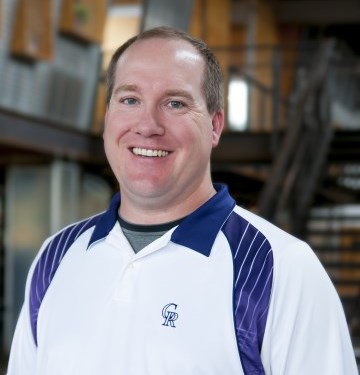On Monday, August 28, Andrea and I got up early to go tour the Duomo. The Basilica of Santa Maria del Fiore is far and away the most recognized landmark of Florence. After walking all the way around the basilica, we found the entrance to the climb to the cupola of Brunelleschi’s dome. The climb to the top of the dome covers 463 steps and 375 vertical feet. In the middle of the climb, you are treated to a wonderful, up-close view of the frescoed interior of the dome and the stained glass around it. Continuing up into the dome, the herringbone brick pattern that Brunelleschi used to make the dome self supporting becomes evident, and the stairs arch to match the curvature of the dome.
From the top of the dome, we were treated to a truly incredible view of the city of Florence. The Duomo is the tallest building in the city by a wide margin, and enjoys a commanding view of the surrounding city. We spent about 30 minutes at the top of the dome enjoying the view and laughing at the irony of one of the workers quite literally weeding the dome before we headed back down.
After we got down from the dome, we went inside to tour the interior of the basilica. The inside of the Duomo was probably the least impressive basilica interior of any of the cathedrals that we visited in Italy. The most interesting point was looking up into the frescoed interior of the dome.
We then descended through the floor of the Duomo into the ruins of Santa Reparata. Santa Reparata was the primary cathedral of Florence prior to the construction of the Duomo and the ruins were an interesting look into the layout of an early Roman cathedral. Their is also an altar in the original location in the ruins and there are evidently small services held in Santa Reparata to this day.
Upon leaving the Duomo and Santa Reparata, we walked around the Baptistry of San Giovanni. We had intended to go in at this point but there was a service in progress, so we paused to view all of the famous bronze doors by Andrea Pisano and Lorenzo Ghiberti. The most famous of these doors is the “Gates of Paradise” by Ghiberti.
After leaving the Duomo complex, we went to the Basilica di Santa Croce. Santa Croce is the main Franciscan church in Florence and is famed for its many funerary monuments. Santa Croce has become well known as the burial place of the most famous Italians. The basilica contains the tombs of Michelangelo, Galileo Galilei, Lorenzo Ghiberti and Niccolo Machiavelli among others. It also contains a funerary monument to Dante Aligheri, although he is not buried here.
We spent about three and a half hours in Santa Croce following the audioguide to the basilica which was very informative and well worth the money. Santa Croce contains a number of famous artworks as well as the funerary monuments. The most notable are Donatello’s Annunciation in bronze and the Crucifixion by Cimabue, although the Crucifixion was badly damaged in the flood of 1966. The whole of Santa Croce was submerged in 13 meters of water during this flood.
After leaving Santa Croce, we went to see Tempio Maggiore, the beautiful Jewish Synagogue in Florence. The synagogue is an instantly recognizable building in the Florence skyline because of it’s bright green copper roof. Entrance to the synagogue was highly restricted and you had to leave everything except ID and paper money in lockers at the fence controlling access to the building. The interior of the building is beautiful and contains a small museum about the history of the Jews in Florence. The synagogue was used as a garage by the Nazis in World War II and they attempted to destroy it as they were leaving, although they only succeeded in blowing a small hole in one wall. The synagogue was also damaged by waters that were 2-3 meters deep in the 1966 flood. The synagogue did have a very helpful young member of the congregation there to answer questions about the building as well.
Following the synagogue, we went back for a tour of the Baptistry of San Giovanni outside of the Duomo. The Baptistry was an interesting building with a beautiful gilded mosaic ceiling. The inlaid marble walls and mosaic floors were also impressive.
After we left the Baptistry, we went back to the Mercato di San Lorenzo to attempt to find Andrea a leather jacket. We ended up returning to a store we had visited a couple of days earlier, Massimo Leather, where we ended up having her jacket custom ordered. We also ended up visiting a number of other shops where we purchased a number of gifts for our family members.
We then returned to our hotel to drop off our things before going to dinner a restaurant called Ottorino. We both had classic Florentine food to enjoy our last night in Florence, and the food was wonderful. I would definitely recommend Ottorino for someone looking for a slightly more upscale restaurant with good Florentine food and excellent service.
